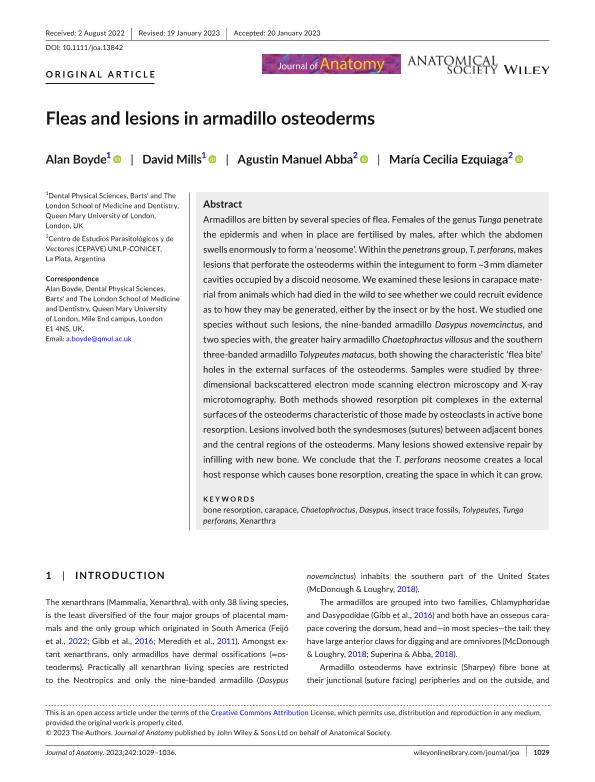Mostrar el registro sencillo del ítem
dc.contributor.author
Boyde, Alan
dc.contributor.author
Mills, David
dc.contributor.author
Abba, Agustin Manuel

dc.contributor.author
Ezquiaga, María Cecilia

dc.date.available
2024-02-16T14:47:35Z
dc.date.issued
2023-06
dc.identifier.citation
Boyde, Alan; Mills, David; Abba, Agustin Manuel; Ezquiaga, María Cecilia; Fleas and lesions in armadillo osteoderms; Wiley Blackwell Publishing, Inc; Journal of Anatomy; 242; 6; 6-2023; 1029-1036
dc.identifier.issn
0021-8782
dc.identifier.uri
http://hdl.handle.net/11336/227240
dc.description.abstract
Armadillos are bitten by several species of flea. Females of the genus Tunga penetrate the epidermis and when in place are fertilised by males, after which the abdomen swells enormously to form a ‘neosome’. Within the penetrans group, T. perforans, makes lesions that perforate the osteoderms within the integument to form ~3 mm diameter cavities occupied by a discoid neosome. We examined these lesions in carapace material from animals which had died in the wild to see whether we could recruit evidence as to how they may be generated, either by the insect or by the host. We studied one species without such lesions, the nine-banded armadillo Dasypus novemcinctus, and two species with, the greater hairy armadillo Chaetophractus villosus and the southern three-banded armadillo Tolypeutes matacus, both showing the characteristic ‘flea bite’ holes in the external surfaces of the osteoderms. Samples were studied by three-dimensional backscattered electron mode scanning electron microscopy and X-ray microtomography. Both methods showed resorption pit complexes in the external surfaces of the osteoderms characteristic of those made by osteoclasts in active bone resorption. Lesions involved both the syndesmoses (sutures) between adjacent bones and the central regions of the osteoderms. Many lesions showed extensive repair by infilling with new bone. We conclude that the T. perforans neosome creates a local host response which causes bone resorption, creating the space in which it can grow.
dc.format
application/pdf
dc.language.iso
eng
dc.publisher
Wiley Blackwell Publishing, Inc

dc.rights
info:eu-repo/semantics/openAccess
dc.rights.uri
https://creativecommons.org/licenses/by/2.5/ar/
dc.subject
BONE RESORPTION
dc.subject
CARAPACE
dc.subject
CHAETOPHRACTUS
dc.subject
DASYPUS
dc.subject
INSECT TRACE FOSSILS
dc.subject
TOLYPEUTES
dc.subject
TUNGA PERFORANS
dc.subject
XENARTHRA
dc.subject.classification
Zoología, Ornitología, Entomología, Etología

dc.subject.classification
Ciencias Biológicas

dc.subject.classification
CIENCIAS NATURALES Y EXACTAS

dc.title
Fleas and lesions in armadillo osteoderms
dc.type
info:eu-repo/semantics/article
dc.type
info:ar-repo/semantics/artículo
dc.type
info:eu-repo/semantics/publishedVersion
dc.date.updated
2024-02-15T14:07:35Z
dc.journal.volume
242
dc.journal.number
6
dc.journal.pagination
1029-1036
dc.journal.pais
Reino Unido

dc.journal.ciudad
Londres
dc.description.fil
Fil: Boyde, Alan. University of London; Reino Unido
dc.description.fil
Fil: Mills, David. University of London; Reino Unido
dc.description.fil
Fil: Abba, Agustin Manuel. Consejo Nacional de Investigaciones Científicas y Técnicas. Centro Científico Tecnológico Conicet - La Plata. Centro de Estudios Parasitológicos y de Vectores. Universidad Nacional de La Plata. Facultad de Ciencias Naturales y Museo. Centro de Estudios Parasitológicos y de Vectores; Argentina
dc.description.fil
Fil: Ezquiaga, María Cecilia. Consejo Nacional de Investigaciones Científicas y Técnicas. Centro Científico Tecnológico Conicet - La Plata. Centro de Estudios Parasitológicos y de Vectores. Universidad Nacional de La Plata. Facultad de Ciencias Naturales y Museo. Centro de Estudios Parasitológicos y de Vectores; Argentina
dc.journal.title
Journal of Anatomy

dc.relation.alternativeid
info:eu-repo/semantics/altIdentifier/url/https://onlinelibrary.wiley.com/doi/10.1111/joa.13842
dc.relation.alternativeid
info:eu-repo/semantics/altIdentifier/doi/http://dx.doi.org/10.1111/joa.13842
Archivos asociados
